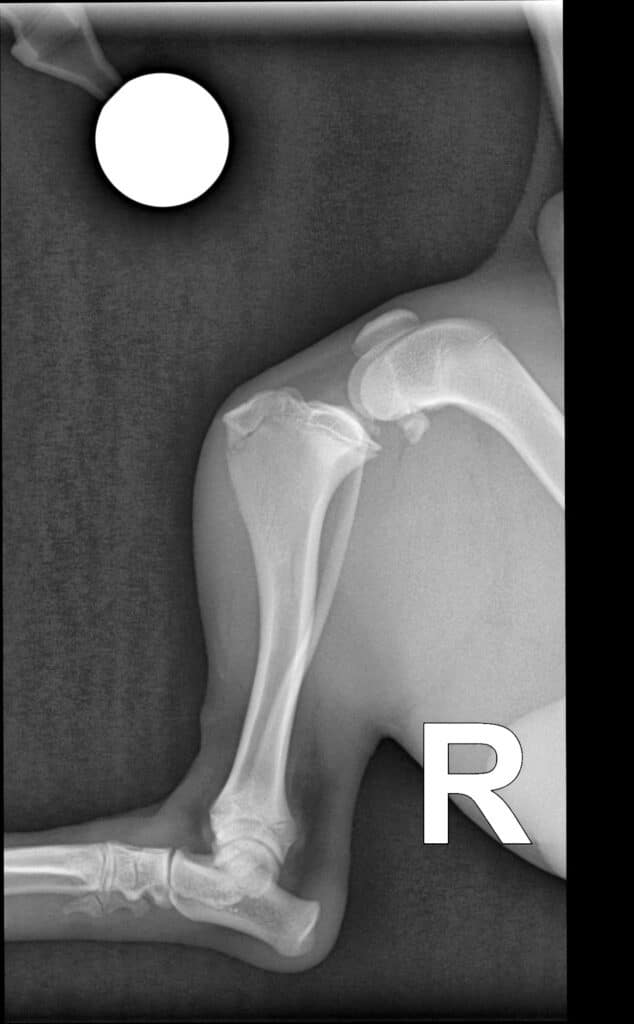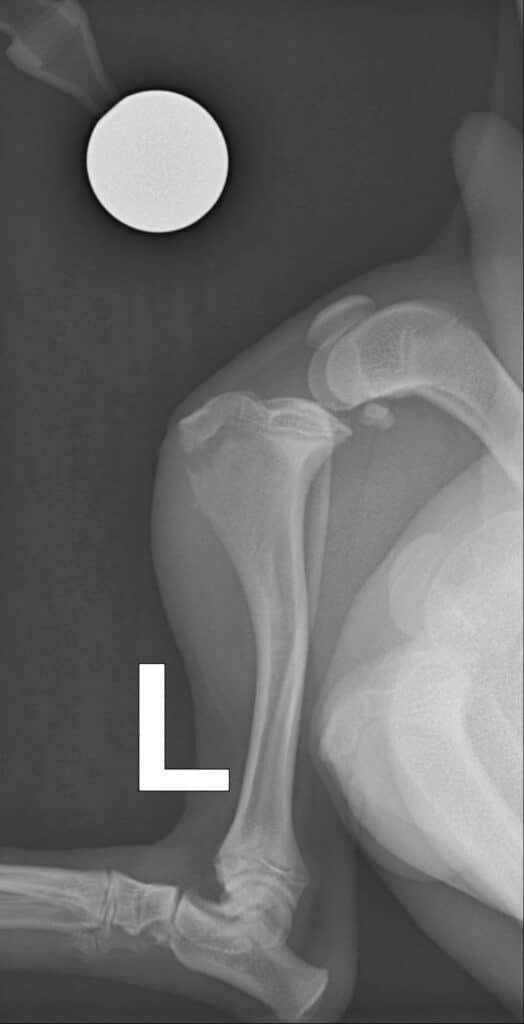- What is Apophysiolysis of the Tibial Tuberosity in Dogs?
- Causes of apophysiolysis of the tibial tuberosity in dogs
- Symptoms of apophysiolysis of the tibial tuberosity in dogs
- Diagnosis and treatment of apophysiolysis of the tibial tuberosity in dogs
- Surgical intervention for apophysiolysis of the tibial tuberosity in dogs
- Follow-up and rehabilitation of apophysiolysis of the tibial tuberosity in dogs
- Frequently asked questions about apophysiolysis of the tibial tuberosity in dogs
- What are the first signs of apophysiolysis of the tibial tuberosity in dogs?
- Is apophysiolysis of the tibial tuberosity in dogs curable?
- How long does it take to recover from surgery for tibial tuberosity apophysiolysis in dogs?
- What can I do to help my dog after surgery for tibial tuberosity apophysiolysis?
- Prevention of apophysiolysis of the tibial tuberosity
- Summary
- Long-term effects and prognosis
- The role of the veterinarian
- conclusion
Apophysiolysis of the tibial tuberosity in dogs is a health problem that can occur in many dogs, especially those in the growing phase. This bone disease can significantly affect the animals' musculoskeletal system and often leads to visible discomfort.
What is Apophysiolysis of the Tibial Tuberosity in Dogs?
Apophysiolysis of the tibial tuberosity in dogs is a pathological condition in which the growth plate (apophysis) at the tip of the shinbone (tibia) separates from the rest of the bone. This can result in a range of symptoms including pain, lameness and, in severe cases, a change in gait.


Causes of apophysiolysis of the tibial tuberosity in dogs
The exact cause of this condition is not fully known, but is often associated with overuse of the affected area. Young dogs that are growing are particularly susceptible to this condition because their bones and joints are still growing and are therefore more susceptible to injury.
Symptoms of apophysiolysis of the tibial tuberosity in dogs
Symptoms of apophysiolysis of the tibial tuberosity can vary but are often visible and include:
- Lameness or an unusual gait
- Visible swelling or redness around the knee joint
- Pain when moving or touching the affected area
- General restriction of movement
Diagnosis and treatment of apophysiolysis of the tibial tuberosity in dogs
A thorough clinical examination is necessary for the diagnosis of apophysiolysis of the tibial tuberosity Imaging tests such as X-rays or ultrasound can also be helpful in determining the exact location and severity of the apophysiolysis.
Treatment for apophysiolysis of the tibial tuberosity may vary depending on the severity of the disease. In many cases, conservative therapeutic approaches such as physical therapy and pain management may be sufficient. However, in severe cases, surgical intervention may be necessary to restore function and stability to the affected area.
Recognizing the first signs leads to a diagnosis by a veterinarian, who then creates a treatment plan. Treatment may include conservative therapy that includes rest and pain management followed by physical therapy. Alternatively, surgical intervention may be required, which involves surgery and subsequent post-operative care. After either course of treatment, follow-up care and regular examinations are necessary, followed by an assessment of recovery.
Surgical intervention for apophysiolysis of the tibial tuberosity in dogs
In severe cases of apophysiolysis of the tibial tuberosity in dogs , when conservative treatment methods are not sufficient, surgical intervention may be necessary to restore the structure and function of the affected area. The type of procedure depends on various factors, including the dog's age, the severity of the condition and general health.
Surgery usually involves reattaching the detached growth plate to the rest of the tibia. This can be accomplished through the use of special medical screws or wire designed to hold the growth plate in place while it heals.
It is important to note that surgical intervention always carries the risk of complications, including infection, postoperative pain and possible problems with healing. Therefore, this option should only be considered if other treatment methods have failed or if the dog's condition requires surgery.
Follow-up and rehabilitation of apophysiolysis of the tibial tuberosity in dogs
Follow-up care after surgery is crucial for a successful recovery. This may include a combination of rest, physical therapy, and regular follow-up visits with the veterinarian.
Physiotherapy plays a crucial role in rehabilitation after surgery by helping to improve mobility of the affected area and increasing muscle strength. This can help reduce the risk of future injuries and may help your dog return to normal activity more quickly.
Regular follow-up examinations by the veterinarian are also important in order to monitor the healing process and detect any complications early on.
Overall, surgical treatment of apophysiolysis of the tibial tuberosity careful consideration and planning, as well as dedicated follow-up care to achieve the best possible outcome. As always, your dog's health and well-being is of the utmost importance and should be the primary consideration in any decision regarding treatment.
Frequently asked questions about apophysiolysis of the tibial tuberosity in dogs
What are the first signs of apophysiolysis of the tibial tuberosity in dogs?
The first signs may be lameness or an unusual gait. Your dog may also show signs of pain, especially when the affected area is touched. In some cases, visible swelling or redness may be observed around the knee joint.
Is apophysiolysis of the tibial tuberosity in dogs curable?
Yes, with appropriate and early treatment, this disease can be successfully controlled and cured in most cases. However, the specific treatment depends on the severity of the disease and can range from conservative measures to surgical intervention.
How long does it take to recover from surgery for tibial tuberosity apophysiolysis in dogs?
The length of recovery can vary widely and depends on factors such as the dog's age and overall health, the severity of the condition, and the type of surgery performed. In general, however, you can expect from several weeks to several months.
What can I do to help my dog after surgery for tibial tuberosity apophysiolysis?
Good aftercare is crucial to your dog's recovery after surgery. This may include adequate rest, regular physical therapy, and follow-up veterinary visits. It's also important to give your dog lots of love and support, as this can help promote his recovery and minimize his stress.
Prevention of apophysiolysis of the tibial tuberosity
Prevention of tibial tuberosity apophysiolysis can be achieved through appropriate diet and exercise, as well as regular monitoring of your dog's health. Early diagnosis can also help minimize the risk of long-term complications.
Summary
Tibial tuberosity apophysiolysis is a serious condition that can significantly impact your dog's quality of life. It is crucial to recognize symptoms early and consult a veterinarian to ensure appropriate diagnosis and treatment.
Long-term effects and prognosis
The long-term effects of apophysiolysis of the tibial tuberosity can vary and depend largely on the severity of the disease and the quality of treatment. With early and adequate treatment, the prognosis is usually good. However, in more advanced cases, permanent damage to bone tissue and chronic joint problems can occur.
In most cases, a good prognosis can be achieved by initiating and strictly following comprehensive treatment. However, it is important to have the animal checked regularly by a veterinarian to ensure that the condition is successfully controlled and the animal has an adequate quality of life.
The role of the veterinarian
An experienced veterinarian plays a crucial role in diagnosing and treating tibial tuberosity apophysiolysis . The veterinarian can make an accurate diagnosis and determine the severity of the disease through physical examination and imaging tests.
Once diagnosed, the veterinarian will create an individualized treatment plan tailored to your dog's needs. This plan may include physical therapy exercises, medication to relieve pain, and in some cases, surgery.
conclusion
Apophysiolysis of the tibial tuberosity is a complex disease that requires careful treatment and management. Early detection and appropriate treatment can reduce the risk of complications and improve your dog's quality of life. Always trust your veterinarian’s expertise and don’t be afraid to ask for support and advice. Your dog relies on you, and your care can help maintain his long-term health and well-being.
Literature on the topic
I would be happy to provide you with relevant literature on the subject of apophysiolysis of the tibial tuberosity in dogs:
- Compendium of General Veterinary Surgery: For Study and Practice (vet.kolleg) - Martin Kramer (2003)
- DJF Pfeil et al.: Does Osgood-Schlatter Dieselase exist in the dogs? Review of human and canine literature and proposed classification system for tibial tuberosity avulsions in the immature dog. In: Vet. Comp. Orthop. Traumatol. 22 (2009), pp. 257–263.
- Ferenc Kása et al.: Apophyseal necrosis of the tibia tuberosity (Schlatter-Osgood disease). In: PF Suter and B. Kohn (eds.): Internship at the dog clinic. Parey, 10th ed. 2006, pp. 969-970. ISBN 3-8304-4141-X
Please note that this is literature from recent years and it is advisable to always consult the most current research.
